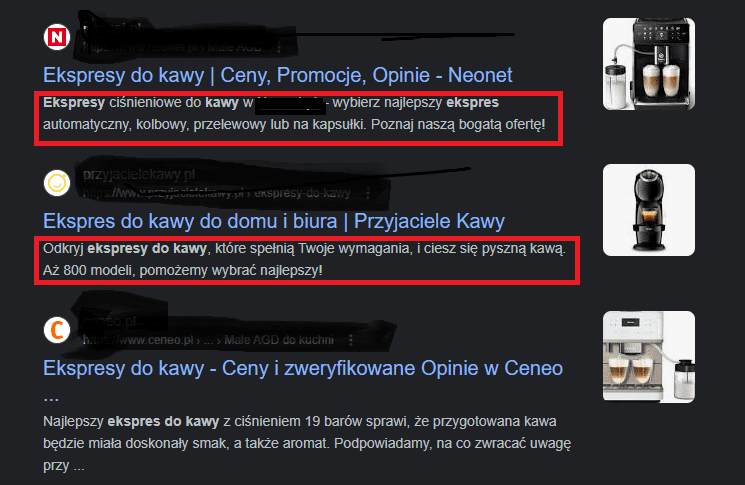Anyone involved in Internet marketing has heard of SEO (Search Engine Optimization) – the process of optimizing a website for search engines. I, however, advocate a comprehensive approach that produces better results, namely SXO (Search Experience Optimization).
Are you looking for someone who will take care of increasing your site’s visibility from A to Z, not “by the book”? Call or write – I will tell you about the details.
SXO: what is it?
SXO, or Search Experience Optimization, refers to optimizing a website for the user’s search experience. SXO’s goal is to provide users with the best possible search results that are not only relevant and accurate, but also easy to find and engaging. SXO focuses on making sure users are satisfied with their experience on the site, which leads to more conversions and higher ranking in search results.
Ready to grow?
The difference between SEO and SXO
SEO and SXO share a common goal: increasing a site’s visibility in search results, but they differ in their approaches.
SEO focuses mainly on optimizing the content and structure of the site, while SXO focuses on the total user experience. I prefer this approach because it simply makes your site better, not just bumps it to a higher position in Google.
SXO takes into account factors such as site usability, performance, responsiveness on mobile devices and content quality. As a result, it provides more valuable information to users, which translates into better search engine results.
Benefits of SXO
There are many benefits to using SXO in a marketing strategy. Here are some of them:
- Higher ranking in search results: improving the user experience on the site results in better search engine results, which increases the visibility of the site and generates more organic traffic.
- More conversions: good SXO leads to more conversions. Users who have a positive experience on the site are more likely to make a purchase, subscribe or perform another action.
- Stronger brand reputation: a site that offers a good user experience builds a positive brand reputation. Users will be more likely to recommend such a site to others, which contributes to brand awareness.
- Competitive advantage: the rise in popularity of SXO is leaving websites that don’t invest in user experience optimization behind. Therefore, the use of SXO can give you a competitive advantage.
Key SXO factors
For SXO to be effective, I take into account many factors. Here I have collected only a list, in my opinion, of the most important:
1.Quality of content
Content quality plays a key role when I perform an SXO audit. Content should be valuable, in line with user expectations and easy to understand. In addition to information, it is worth noting the clear, logical layout of text, graphics, etc. Content shouldn’t just be a clog where you put as many keywords as possible.
2.Usability of the site
The usability of the site is of great importance to SXO. It should be intuitive and easy to navigate. A well-thought-out menu and short loading times are worthwhile.

3.Optimization for mobile devices
Nowadays, more and more people are using mobile devices to browse the Internet and make online purchases. It is important that the site is optimized for screens of different resolutions. Developers I work with always consider responsiveness on mobile devices.
4.Page loading speed
Page loading speed is critical to the user experience. Users expect the site to load quickly and respond to their actions. That’s why it’s important to optimize page load time, such as by compressing images, minimizing code and using the browser’s cache.
Stay up to date with SEO news!
Sign up for the newsletter
How do I conduct an SXO audit?
In order for SXO marketing to be effective, to begin with, you need to analyze what the current state of your site is. This way, we know what needs to be refined and can plan the SXO strategy. I pay attention primarily to such elements as:
Keyword analysis
I will check if you are using keywordsthat have the greatest potential to increase traffic to your site, and then – sales. I also take into account the competition, because there may be phrases for which you can increase visibility fairly quickly, without a lot of time and money.
Evaluation of site structure
I check that the site has a clear structure. It happens that what seems logical and intuitive to you, for the customer is no longer so perfectly understood. Analyzing site traffic allows you to assess what is standing in the way of making your site better in terms of UX.
Performance testing
I also test the site’s performance by checking loading times and responsiveness on different devices. It happens that the website has great results on desktop, but on mobile it already leaves a lot to be desired – this way you lose a lot of customers, so it’s worth working on it.
User experience evaluation
Looking at the site with fresh eyes allows you to find areas that make navigation difficult, frustrating or confusing for the user. Sometimes even minor shortcomings cause you to lose customers, so when necessary I engage SXO developers to make the necessary adjustments to the site.
SXO marketing as a strategy
SXO marketing is first and foremost a strategy, focused on optimizing the user experience on the website. It provides a broader view of sales than SEO, which focuses mainly on getting higher and higher rankings.
Here are some of the SXO strategies I implement:
Creating valuable content
The key to successful SXO marketing is creating valuable content. They should be unique, attractive and provide users with the information they need. Here, it makes sense to focus on solving user problems and providing guidance and advice.
Optimized meta descriptions
It has long been said that meta descriptions are not an SEO ranking factor, and this is … true. However, along the lines of SXO, I would not give up on completing the meta description, because if they are well-written and include a CTA, they effectively encourage clicks and thus increase CTR. And this has already affected the visibility of the site as much as possible.

Personalization and targeting
Personalization and targeting are important for SXO marketing. Tailor content and offers to users’ preferences and needs. Use user demographics and behavior to deliver more targeted and personalized content.
Common SXO mistakes: how to avoid them?
During the implementation of SXO, several mistakes can be made that negatively affect the results. Here are some common SXO errors:
Too aggressive insertion of keywords
Focusing too much on inserting keywords can lead to unreadable and artificial content. It is better to focus on creating content that actually has real value for the user.
Neglecting to optimize for mobile devices
If you don’t take care of the UX of users using smartphones and tablets, you are losing hundreds of potential customers. The days when marketing was based mainly on the desktop are long gone.
No competitive analysis
Competitive analysis is important in SXO, as standards continue to move forward. It is worth learning not only from the successes, but also from the mistakes of the competition.
The future of SXO
SXO is a constantly evolving field. With advances in technology and changing user preferences, SXO is sure to continue to evolve. The future of SXO may include even greater personalization of content, the use of artificial intelligence to better understand user intent, and increasingly sophisticated data analysis techniques.
Want something more comprehensive and effective than ordinary SEO? Contact me – let’s talk about how to rock the traffic and sales on your site with SXO.











